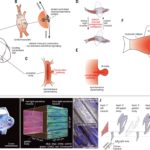News, Biohybrid fish made from human cardiac cells swims autonomously
Researchers at Harvard and Emory University created a biohybrid fish using paper, plastic, gelatin, and two muscle layers. These muscle layers were created from human cardiac cells. The design of the model fish was based on zebra fish, with a muscle layer on either side of the tail fin. When one side contracts, the other side stretches releasing proteins that causes a contraction. This creates a closed loop which was able to autonomously propel the fish for over 100 days, sustained by nutrients added in the swimming fluid.
The ultimate goal is to create artificial hearts. This is not the first biohybrid device made by the team, having already created biohybrid pumps with rat cardiac cells. The purpose of these experiments is to understand how the heart works. While it’s easy to something that looks like a heart, it’s difficult to build a something that also works like a heart. By replicating the heart functions in the fish, it allows the researchers to better observe and understand how the heart functions.
Not only for healing hearts, this work shows the exciting prospect of biohybrid bots. From robotics, development of bio-computer chips to even ethical concerns, there are many applications and conversations to be held as the technology matures. I believe the future of computation is in biology.
Learn about our two Decals!
 Click here to find out more about our Fall Bioinspired Design Decal and our Spring Bioinspired Design in Action Decal – ALL MAJORS are welcome.
Click here to find out more about our Fall Bioinspired Design Decal and our Spring Bioinspired Design in Action Decal – ALL MAJORS are welcome.Berkeley BioDesign Community
 Click here to learn about the BioD: Bio-Inspired Design @ Berkeley student organization or here to signup for more info.
Click here to learn about the BioD: Bio-Inspired Design @ Berkeley student organization or here to signup for more info.Search
Student Login





I imagine that the neurological circuits underlying these processes are governed by both 2d spacing maps with their brains as…
to reduce the impact of car accidents, it may be possible to study the force diverting physics of cockroaches to…
you see this type of head-bobbing stability in many avian creatures related to pigeons like chickens. the head ability to…
not like they taught horses how to run! this is an example of convergent evolution where both sea creatures and…
The brain functions in a similar way with neuronal connections. our brains are able to utilize the multiplicity of connections…